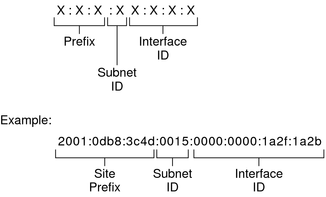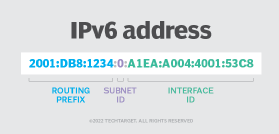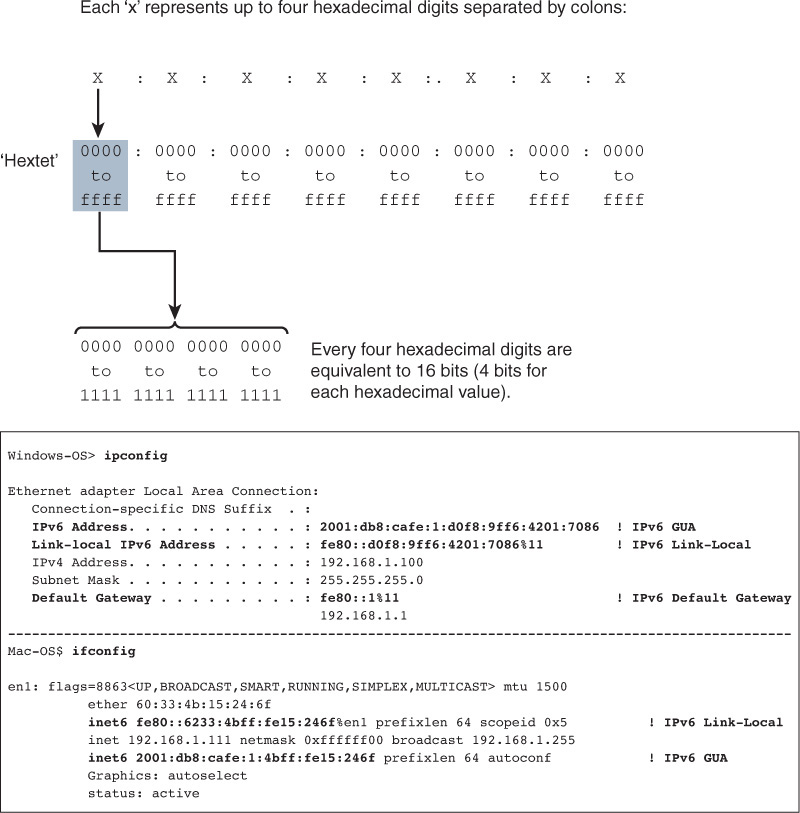A Ipv6 Follows Ipv5 Which Used 48-bit Addresses
IPv6 Address is the new generation IP address that is mainly deveoped to overcome IPv4 exhaust and its limitations. Here the fourth part of the IPv6 address 2F3B is the subnet part.

Ipv6 Addressing Overview System Administration Guide Ip Services
2001cdba32579652 View Answer Answer.

. Which of the following is true of IPv6 addresses. IPv4 addresses are 32-bit long. Which of the following is true of IPv6 addresses.
This was mainly due to the 32-bit limitation. IPv6 follows IPv5 which used 48-bit addresses. An IPv6 Normal address has the following format.
Which of the following is an IPv6 addressA. A they cannot be used for voice and video applications B Windows Server 2012 does not support them C they are 128 bits in length D IPv6 follows IPv5 which used 48-bit addresses. The address space in IPv4 is 429 109.
Which means that currently first 48 bits of an IPv6 address are used to identify the network globally. IPv6 allows for a maximum of about 340 trillion trillion trillion addresses. IPv5 is a version of internet protocol IP that was never formally adopted as a standard.
D Latest N10-007 Dumps Valid Version with 601 QAs Latest And Valid QA Instant Download Once Fail Full Refund Instant Download N10-007 PDF. A they are 128 bits in length B Windows Server 2008 does not support them C IPv6 follows IPv5 which used 48-bit addresses D they cannot be used for voice and video applications. For the new technologies more IP addresess needed and for this need a new IP version has developed.
IPv6 is much more about scaling networks with route summarization in mind that just supporting lots of devices. IPv6 follows IPv5 which used 48-bit addresses d. Windows Server 2008 does not support them C.
For example this is also where the table IPv6 Subnet Reference IP Address comes in a lot of handy above. In comparison IPv6 addresses are 128 bits which allow for approximately three hundred and forty trillion. The address is a hybrid between a global unicast address that works on the Internet and a link-local unicast address that works on only one link.
The v5 stands for version 5 of internet protocol. This led to the 128-bit IPv6. IPv5 was never accepted as an official internet protocol.
As mentioned before IPv4 uses 32-bit addresses which allows 429 billion unique addresses. Which protocol enables routers to build tables of routing information. They cannot be used for voice and video applications ANS.
IPv6 Internet Protocol Version 6 is designed to work along side IPv4 and may someday replace IPv4. IPv5 was used to define an experimental real-time streaming protocol. Because 32-bit binary numbers are difficult for humans to read IPv4.
To avoid any confusion it was decided to not use IPv5 and name the new IP protocol IPv6. We can say that IPv6 is the. Every business for example gets a 48 thats 2 16 networks and best practices are to leave the following 48 unallocated so that the customer can grow if needed.
Which of the following is true of IPv6 addresses. Consider an IPv6 example. The segments are separated by colons - not periods.
The IETF Internet Engineering Task Force began working on IPv6 Internet Protocol Version 6 a standard for a 128-bit IP address in 1998. IPv6 has been in the works since 1998 to address the shortfall of IP addresses available under Ipv4 yet despite its efficiency and security advantages adoption is still slow. Y where y is called a segment and can be any hexadecimal value between 0 and FFFF.
IPv4 supports DHCP and Manual address configuration. Why is it called IPv5. Windows Server 2008 does not support them d.
Each address was made up of four sets of numbers between 0 and 255. IPv6 supports renumbering and auto address configuration. The address space in IPv6 is 34 1038.
Another thing is that IPv6 has a high span of IP adresses that is up to 340 trillion trillion trillions. IPv6 addresses are assigned to organizations in much larger blocks as compared to IPv4 address assignmentsthe recommended allocation is a 48 block which contains 2 80 addresses being 2 48 or about 28 10 14 times larger than the entire IPv4 address space of 2 32 addresses and about 72 10 16 times larger than the 8 blocks of IPv4 addresses which are the largest. The IETF anticipating the need for more IP addresses created IPv6 to accommodate the growing number of users and devices accessing the Internet.
Show activity on this post. A new instance of that matching class type is constructed. The var statement creates an empty named container that is typed as an instance of a class.
As you know IPv4 Addresses were limited and exhaused shortly. In most cases a subnet calculator will not be required since IPv6 using hex hexadecimal and so long as the prefix length is a multiple of 4 it makes it quite easy. They cannot be used for voice and video applications.
They are 128 bits in length c. Internet Protocol version 6 IPv6 is the most recent version of the Internet Protocol IP the communications protocol that provides an identification and location system for computers on networks and routes traffic across the InternetIPv6 was developed by the Internet Engineering Task Force IETF to deal with the long-anticipated problem of IPv4 address exhaustion and is. IPv6 follows IPv5 which used 48-bit addresses D.
IPv6 addresses are 128 bits long. End to end connection integrity can be done in IPv6. Windows Server 2008 does not support them.
This new Internet Protocol version is IPv6 Internet Protocol version 6. Which protocol enables routers to build tables of routing information. They cannot be used for voice and video applications.
IPv6 follows IPv5 which used 48-bit addresses b. They are 128 bits in length B. An IPv6 normal address must have eight segments however a short form notation can be used in the Tape Library Specialist Web interface for segments that are zero or.
A single interface will have multiple IPv6 addresses of different types. This answer is not useful. 21DAD348 the first three fixed bits 001 and remaining 45 bits 453 48 bits is a route prefix and 21DAD302F3B64 is a subnet prefix.
IPV5 used the same addressing system as IPv4.

Ipv6 Address Representation And Address Types Representation Of Ipv6 Addresses Cisco Press
Comments
Post a Comment